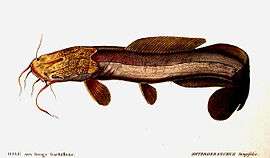Vundu
| Vundu Temporal range: Lower Pliocene - Present | |
|---|---|
 | |
| Scientific classification | |
| Kingdom: | Animalia |
| Phylum: | Chordata |
| Class: | Actinopterygii |
| Order: | Siluriformes |
| Family: | Clariidae |
| Genus: | Heterobranchus |
| Species: | H. longifilis |
| Binomial name | |
| Heterobranchus longifilis Valenciennes, 1840[2] | |
The vundu (Heterobranchus longifilis) is a large species of airbreathing catfish found widely in rivers and other freshwater habitats of sub-Saharan Africa, as well as the Nile.[1] It is also called the solomon fish, tsuni, mazunda, sampa, cur, lenda, or certa.[3]
Description
The vundu is the largest freshwater fish in southern Africa, reaching over 150 cm (5 ft) in length. The maximum recorded weight is 55 kg (121 lb).[2] Few other catfish have such large second dorsal (adipose) fins or such long barbels as do the Vundu. Its barbels nearly reach to the origin of the pelvic fin. The colour of Heterobranchus longifilis is light to dark olive brown on its dorsal surface, getting lighter over the mid-body to a light brown. Its belly is off-white. Fins are usually light brown.[4]
With its serpent-like body, it can charge with powerful bursts of speed, and is strong enough to pull a man down to the bottom of the river.
Habitat and range
The vundu is found widely in rivers and other freshwater habitats of sub-Saharan Africa, only extending beyond this region in the Nile (although it is rare in the lower sections of this river). Among others, it is found in the Benue River, Volta River, Niger River, Gambia River, Senegal River, Lake Chad, Omo River, Congo River Basin, Lake Rukwa, Lake Kariba, Zambezi River, Lake Tanganyika and Lake Edward.[1]
The vundu is generally uncommon, but it is not considered threatened despite having declined locally.[1] Most active at night, it feeds on any available food, including invertebrates and insects when small, then fish and other small vertebrates when large. It scavenges off large carcasses and offal from riverside villages. It can live for 12 or more years.[2] The vundu catfish can survive out of water for extensive periods of time.[4]
References
- 1 2 3 4 Azeroual, A.; Bills, R.; Getahun, A.; Hanssens, M.; Kazembe, J.; Marshall, B. & Moelants, T. (2010). "Heterobranchus longifilis". IUCN Red List of Threatened Species. Version 2015.2. International Union for Conservation of Nature.
- 1 2 3 Froese, Rainer and Pauly, Daniel, eds. (2010). "Heterobranchus longifilis" in FishBase. May 2010 version.
- ↑ "Animal.discovery.com". Retrieved 5 May 2010.
- 1 2 "Catfish1.com". Retrieved 5 May 2010.
Further reading
- Toko, Imorou (1 2) ; Fiogbe, Emile D., Koukpode, Bruno, Kestemont, Patrick (2007). Rearing of African catfish (Clarias gariepinus) and vundu catfish (Heterobranchus longifilis) in traditional fish ponds (whedos) : Effect of stocking density on growth, production and body composition. ISSN 0044-8486. CODEN AQCLAL. 2007, vol. 262, no. 1, pp. 65–72.
- Vundu in aquaculture
